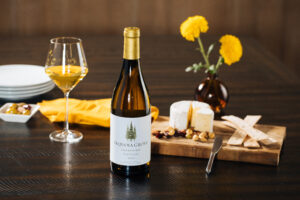Demonstrating that a nonprofit is everything it seems to be, and establishing
just how much support a winery is giving to its cause, is essential.
By Kathleen Willcox
In an era of fake news, deepfakes and rampant cheating and trickery courtesy of Artificial Intelligence (AI), more and more people are craving authenticity. Unfortunately, they don’t believe they’re getting it: a recent Global Trustworthiness Monitor from Ipsos found that 14% of people polled in 31 countries trust politicians, and 25% trust journalists.
While they can’t control who’s ruling their country or how news gets disseminated, they can vote with their wallet.
A recent study conducted by OnePoll found that young adults are actively demanding more from brands they support. About 80% of Gen Z and millennials are more likely to buy from brands whose mission or purpose they support. About 51% actively seek out eco-friendly products. Seventy-four percent report being likely to boycott brands that go against their personal ethos: that includes mistreating or underpaying workers (61%) and failing to be inclusive (51%).
But how can wine lovers know if the brand they’re supporting is actually actively supporting the cause(s) they claim to be supporting?
As with terms such as “sustainability” and “natural,” which are regularly deployed by demonstrably problematic brands, there is no legal protection around the terms that brands use to describe their partnerships with nonprofits and charities.
Also of concern: in this environment, how can wineries themselves clearly demonstrate their authenticity?
Good-Washing vs. Good-Doing
Demonstrating that a nonprofit is everything it seems to be, and establishing just how much support a winery is giving to its cause, is essential.
 For Lauren Fremont, executive director of the nonprofit Winegrowers of Dry Creek Valley, a Sonoma County, Calif., trade association that includes 150 growers and 60 wineries with 9,000 acres under vine, both issues are close to her heart.
For Lauren Fremont, executive director of the nonprofit Winegrowers of Dry Creek Valley, a Sonoma County, Calif., trade association that includes 150 growers and 60 wineries with 9,000 acres under vine, both issues are close to her heart.
“Our Passport to Dry Creek Valley is California’s longest-running wine event weekend, and that event alone generates 80% of our revenue,” Fremont explains. “We are very open about that. Transparency and accountability are key. Wineries should be able to provide explicit information on the percentage of sales or revenue that will be donated to a nonprofit.”
 There’s no universal benchmark for the ideal percentage, but a contribution of 5% or more, or a large lump annual sum, demonstrates genuine commitment to the cause, she notes. Also, it should be clear how the donated funds will be spent.
There’s no universal benchmark for the ideal percentage, but a contribution of 5% or more, or a large lump annual sum, demonstrates genuine commitment to the cause, she notes. Also, it should be clear how the donated funds will be spent.
Consumers can protect themselves in a number of ways — and brands can help demonstrate their bona fides by helping buyers verify the details of a partnership. In addition to transparency about the depth of the partnership, they can link to the nonprofit’s profile on Federal Trade Commission-approved sites such as Charity Navigator and BBB Wise Giving Alliance.
Consumers and brands can also check / ensure that a charity is registered and that the donation is tax deductible. Read on for examples of transparent and mutually beneficial brand-nonprofit charities.
Environmental Conservation: Sequoia Grove + Redwoods
For some wineries, aligning with a specific cause or organization formalizes a long-standing commitment.
Sequoia Grove Winery in Napa celebrated its 40th harvest by joining 1% for the Planet, and committing to donating 1% of sales from its vineyard series to the nonprofit Save the Redwoods League.
 “We have always been focused on sustainability in all of its forms,” says winemaker Jesse Fox. “We were one of the first five wineries to be certified through Napa Green, and we have always prioritized conservation. For us, that goes beyond the vineyard. The Sequoia tree is our brand icon, but it goes deeper than that. We really connected with Save the Redwoods’ mission to mitigate the damage done by logging through conservation, replanting and funding grants that ensure access to redwood parks for underrepresented communities.”
“We have always been focused on sustainability in all of its forms,” says winemaker Jesse Fox. “We were one of the first five wineries to be certified through Napa Green, and we have always prioritized conservation. For us, that goes beyond the vineyard. The Sequoia tree is our brand icon, but it goes deeper than that. We really connected with Save the Redwoods’ mission to mitigate the damage done by logging through conservation, replanting and funding grants that ensure access to redwood parks for underrepresented communities.”
Fox says that the trees, which only grow in a narrow strip right along the California Coast, and which help define the culture of the Golden State, share a kinship with the winery’s terroir-driven Vineyard Series in a way that connects with wine lovers.
 “We have a lot of conversations about the Redwoods League in our tasting room, especially because it looks out on a fairy ring of these trees right outside the window,” Fox says.
“We have a lot of conversations about the Redwoods League in our tasting room, especially because it looks out on a fairy ring of these trees right outside the window,” Fox says.
Sequoia Grove’s marketer Kobrand Fine Wine and Spirits, which works with a range of distributors to get their wines in stores across the country, has joined the cause.
“We donate 1% of the sales from the Napa Cabernet annually, which ends up being about $20,000 per year,” Michael Delatizky, senior brand manager at Kobrand, notes. “At Kobrand and the winery, we also highlight the partnership in email blasts, on social media and on our websites.”
Health Education + Detection: J. Lohr + National Breast Cancer Foundation
 Other wineries, including J. Lohr Vineyards and Wines, decide to transform a deeply personal connection to a cause into a partnership with an organization.
Other wineries, including J. Lohr Vineyards and Wines, decide to transform a deeply personal connection to a cause into a partnership with an organization.
The Paso Robles, Calif., winery has supported the National Breast Cancer Foundation (NBCF) for more than 15 years, with $3 of every bottle of Carol’s Vineyard Cabernet Sauvignon going toward the NBCF’s education and detection programs.
 “In 2008, we lost our mother, Carol Waldorf Lohr, to breast cancer complications,” says Cynthia Lohr, the winery’s co-owner and chief brand officer. “To honor her, we wanted to draw attention to the importance of early detection and commemorate her influence on our lives. People come up to me and the family thanking us for the effort, and I’m so grateful for the sincere appreciation and the real-life impact it has made.”
“In 2008, we lost our mother, Carol Waldorf Lohr, to breast cancer complications,” says Cynthia Lohr, the winery’s co-owner and chief brand officer. “To honor her, we wanted to draw attention to the importance of early detection and commemorate her influence on our lives. People come up to me and the family thanking us for the effort, and I’m so grateful for the sincere appreciation and the real-life impact it has made.”
Over the years, that $3 has added up to more than $1 million in support, giving women who would otherwise be unable to afford mammograms access to the service. The program also funds patient navigation services and HOPE Kits, a gift pack of inspirational items for women at all stages in their cancer journey.
Arts and Advocacy: The Prisoner + The Center for Art and Advocacy
At Napa’s The Prisoner Wine Company, the brand’s dedication to the broad cause of prison reform is foundational to its creation. The flagship label and brand name was inspired by a Francisco Goya etching, Le Petit Prisonnier. Its subtitle translates to “the custody is as barbaric as the crime.”
The Prisoner has created multiple initiatives that drive advocacy for prison reform, support the formerly incarcerated and art initiatives. It includes a 3% donation from all online Prisoner Red Blend sales to a rotating roster of organizations that include the Equal Justice Initiative, Rubicon Programs and The Center for Art and Advocacy.
 The brand also launched a limited-edition 300-case wine series dubbed Corrections in 2022. The annual release features artwork from a different artist and benefits the previously incarcerated. This year, the 1.5 liter magnum bottle features a piece by Jesse Krimes titled Apokaluptein:16389067. The piece was created during his 70-month incarceration; Krimes’ organization, The Center for Art & Advocacy, will benefit from the standalone donation of $75,000 following the release. In addition, 5% of Corrections sales will also go to The Center for Art & Advocacy.
The brand also launched a limited-edition 300-case wine series dubbed Corrections in 2022. The annual release features artwork from a different artist and benefits the previously incarcerated. This year, the 1.5 liter magnum bottle features a piece by Jesse Krimes titled Apokaluptein:16389067. The piece was created during his 70-month incarceration; Krimes’ organization, The Center for Art & Advocacy, will benefit from the standalone donation of $75,000 following the release. In addition, 5% of Corrections sales will also go to The Center for Art & Advocacy.
 “We’ve always known the Prisoner to stand for progress and specifically to use art and artistic language to drive progress. Up until recently, that progress was [focused on] changing how luxury wine operates — being more inclusive and approachable, and making sure everyone feels like they have a place in the luxury wine landscape,” says Angela Knotts, brand marketing director of The Prisoner. “Through Corrections, we are committed to using art to drive dialog, advocate and create lasting positive changes for those who have and currently are navigating the complexities of the prison system.”
“We’ve always known the Prisoner to stand for progress and specifically to use art and artistic language to drive progress. Up until recently, that progress was [focused on] changing how luxury wine operates — being more inclusive and approachable, and making sure everyone feels like they have a place in the luxury wine landscape,” says Angela Knotts, brand marketing director of The Prisoner. “Through Corrections, we are committed to using art to drive dialog, advocate and create lasting positive changes for those who have and currently are navigating the complexities of the prison system.”
The brand also walks the walk, Knotts explains, by working with Bay Area organizations and community groups to “implement fair chance hiring at our Napa tasting room.”
The rotational program gives the previously incarcerated experience in hospitality, winemaking and viticulture.
Everybody wins
Ideally, wine-nonprofit relationships serve as a win-win-wine for brands, the organization benefiting and the consumer who can feel good about supporting the pairing.
“From my perspective, it can make all the difference to an organization such as ours,” says Redwoods League Institutional Grants Officer Daniel Schmidt. “We love working with Sequoia Grove because they are really active partners who are able to reach people across the country, people who might not even know about the challenges the Redwoods are facing otherwise.”
__________________________________________________
 Kathleen Willcox
Kathleen Willcox
Kathleen Willcox writes about wine, food and culture from her home in Saratoga Springs, N.Y. She is keenly interested in sustainability issues, and the business of making ethical drinks and food. Her work appears regularly in Wine Searcher, Wine Enthusiast, Liquor.com and many other publications. Kathleen also co-authored a book called Hudson Valley Wine: A History of Taste & Terroir, which was published in 2017. Follow her wine explorations on Instagram at @kathleenwillcox


















